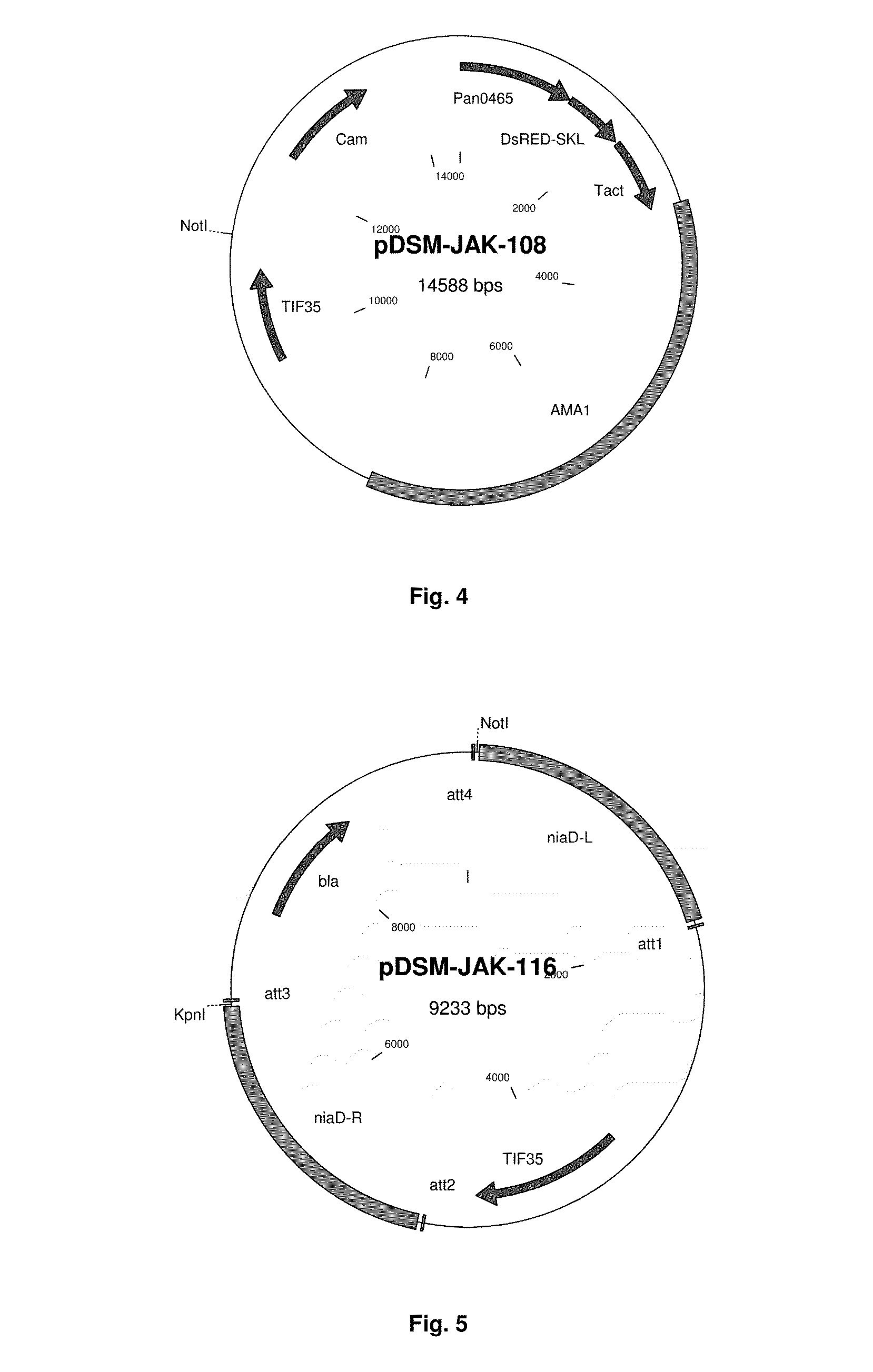Vector-host system
a vector and host technology, applied in the field of vector host system, can solve the problems of requiring continuous use of (expensive) antibiotics, inability to adapt to the environment, etc., and achieve the effects of reducing and increasing the number of host cells
- Summary
- Abstract
- Description
- Claims
- Application Information
AI Technical Summary
Benefits of technology
Problems solved by technology
Method used
Image
Examples
example 2
Preparation of Expression Construct pDSM-JAK-105 with Inducible Promoter
[0254]As putative essential gene, to be used as marker for a novel vector, we choose the P. chrysogenum tif35 gene (Pc22g19890), encoding the g subunit of the core complex of translation initiation factor 3 (eIF3g; Phan et al., 1998 Mol Cell Biol. 18(8):4935-46). Pchr•tif35 gene, ORF, cDNA and protein are shown in SEQ ID NO. 37, 38, 39 and 40, respectively Plasmid pDSM-JAK-105 allowing creation of a strain in which P. chrysogenum tif35 is placed under the control of the inducible niiA promoter was constructed using Gateway Technology as follows.
[0255]A 3951 bp DNA fragment comprising the complete P. chrysogenum niaD gene and the niiA promoter region (nt 2778005 to 2781898 in Genbank AM920428.1) was amplified with the following oligonucleotides:
DSM-JAK-101(SEQ ID NO: 1)5′-GGGGACAAGTTTGTACAAAAAAGCAGGCTGATCGAAGGAAGCAGTCCCTACACTC-3′DSM-JAK-102(SEQ ID no. 2)5′-GGGGACCACTTTGTACAAGAAAGCTGGGTTGAGACTGAACAATGTGAAGACGGAG-3...
example 3
Construction of a P. Chrysogenum Strain with a Nitrate-Inducible tif35 Gene
[0259]Plasmid pDSM-JAK-105 of Example 2 was linearized with AatII in the vector region and transformed into protoplasts of P. chrysogenum DS58274. In this strain an inactivated niaD locus carries a GFP.SKL expression cassette allowing its use as both auxotropic marker as well as a transformation control. Using fluorescence microscopy, we observed that out of 52 nitrate-prototrophic transformants analysed, 44 had retained GFP fluorescence. Colony PCR using the following oligonucleotides:
DSM-JAK-1095′-CAGTTTACACTCAACCCCAATCCAG-3′(SEQ ID NO. 7)3-prime-niaD-forward5′-AGGTTGGTGGAGAAGCCATTAG-3′(SEQ ID NO. 8)
showed that at least half of these carried the PniiA-tif35 locus correctly recombined at the tif35 locus. Multiple independent [PniiA-tif35]-containing transformants were identified, purified by sporulation and NO3+ selection and further analysed. Conidiospores were produced on R agar plates supplemented with ni...
example 4
Construction of a P. Chrysogenum tif35 Deletion Cassette
[0260]To delete the genomic copy of the P. chrysogenum tif35 gene, plasmid pDSM-JAK-106 (FIG. 3) was constructed by Gateway technology. A 1654 bp DNA fragment comprising the region downstream from the P. chrysogenum tif35 terminator (nt 4691355 to 4692956 in Genbank AM920437.1) was amplified with the following oligonucleotides:
DSM-JAK-107(SEQ ID NO. 9)5′-GGGGACAGCTTTCTTGTACAAAGTGGATGGGAAACTAACCACGTGCTTGTACG-3′DSM-JAK-108(SEQ ID NO. 10)5′-GGGGACAACTTTGTATAATAAAGTTGTTCACCCTGTCTCGACTTCCTTGTC-3′
using P. chrysogenum DS54465 DNA as template, recombined into vector pDONR P2R-P3, yielding plasmid pDSM-JAK-104. Plasmids pDSM-JAK-102, pENTR221-niaDF1-amdS-niaDF2 and pDSM-JAK-104 were recombined with vector pDEST R4-R3, yielding plasmid pDSM-JAK-106 (FIG. 3).
PUM
| Property | Measurement | Unit |
|---|---|---|
| Biological properties | aaaaa | aaaaa |
| Efficiency | aaaaa | aaaaa |
Abstract
Description
Claims
Application Information
 Login to View More
Login to View More - R&D
- Intellectual Property
- Life Sciences
- Materials
- Tech Scout
- Unparalleled Data Quality
- Higher Quality Content
- 60% Fewer Hallucinations
Browse by: Latest US Patents, China's latest patents, Technical Efficacy Thesaurus, Application Domain, Technology Topic, Popular Technical Reports.
© 2025 PatSnap. All rights reserved.Legal|Privacy policy|Modern Slavery Act Transparency Statement|Sitemap|About US| Contact US: help@patsnap.com



